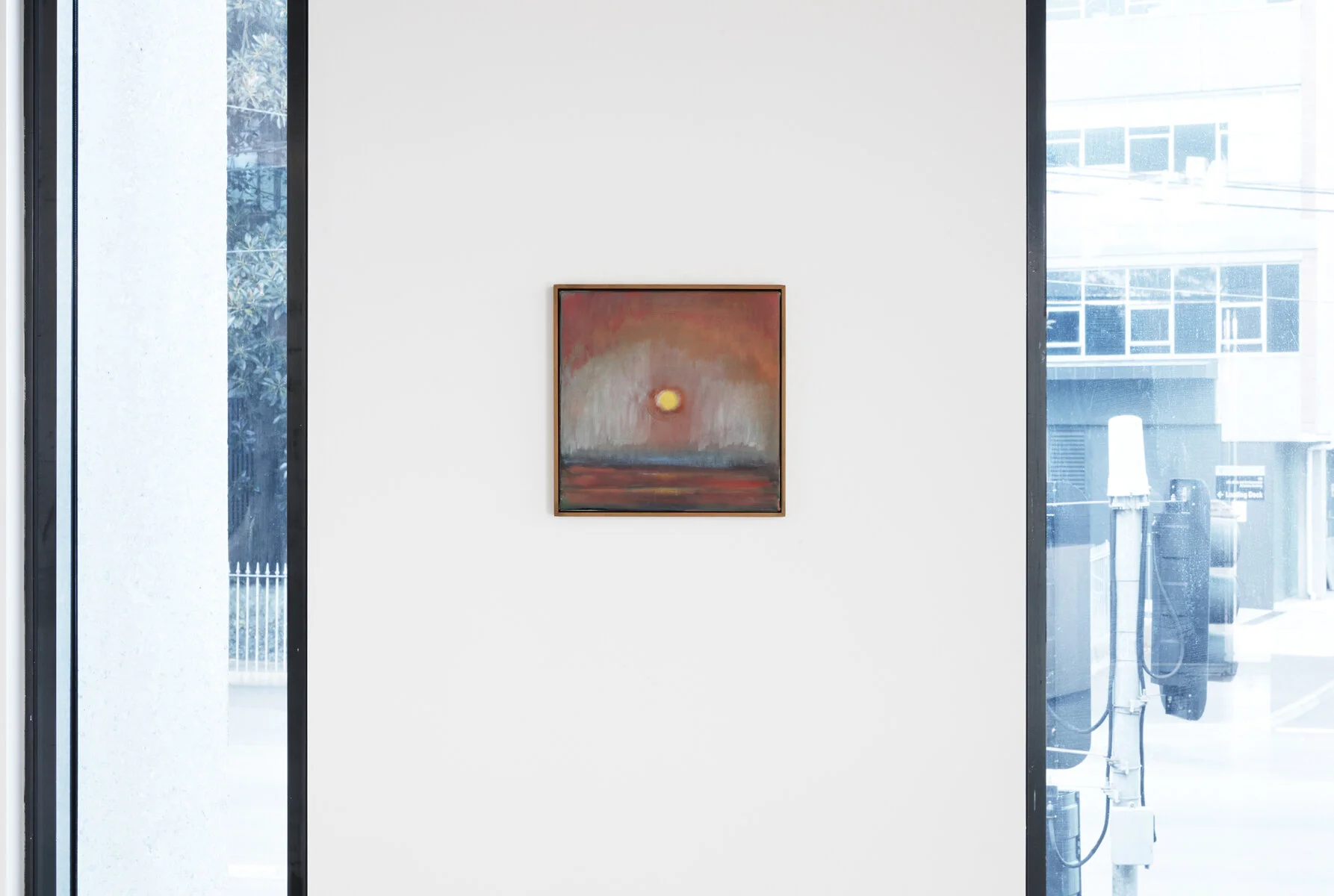SETH BIRCHALL
’HEALTH AND HAPPINESS’
22 JULY – 28 AUGUST, 2021
Seth Birchall, Health and Happiness, installation view, dimensions variable, 2020. Photography by Zan Wimberley.
Video: @hellofuturetv. Music: AnSo
ARTIST STATEMENT
Seth Birchall’s paintings create meditative worlds that look both inward to psychological states and outward to the natural world. His works draw upon romantic notions of landscape as depicted throughout art history, presenting a contemporary twist on impressionism’s gestural brushwork and colour play. Containing fictitious landscapes composited from photographs, his scenes reflect a biophilic urge - to maintain connection with other life forms in nature. Alongside trees are reoccurring motifs of suns, moons, orbs and flowers that form mirrored compositions, sometimes across multiple canvases. His painted environments invite a moment for pause and self-reflection, coaxing us to examine the interior spaces and wanderings of the mind. Within the energy of Birchall’s paintings lies a place of serenity.
Johanna Bear
Seth Birchall, Health and Happiness, installation view, dimensions variable, 2020. Photography by Zan Wimberley.
SEEING TREES
I am walking to my friend’s studio down a street lined with London plane trees. They must be over one hundred years old. At this time of year, their sycamore-like leaves turn brown, fall, and carpet the footpaths, and their fuzzy fruiting globes break apart and disperse, causing those with allergies to cough and sneeze. Today, their thick, silvery-green and yellowish trunks are wrapped in hessian and surrounded by wooden boarding as if prepared for battle. New road is being laid, and steaming, shiny-black bitumen is shovelled from a truck by workers in hi-vis vests. How many roads have these trees seen laid?
Seth Birchall, Health and Happiness, installation view, dimensions variable, 2020. Photography by Zan Wimberley.
Odd, perhaps, to think of trees that see, sessile witnesses to all the life that flits by. But then again we tend to forget the senses of everything that isn’t human, including trees. From signals of scent and colour to the less obvious ways they communicate with each other through a network of mycorrhizal fungi below the ground, trees lead very busy social lives. When they are not muzzled by monocropping and selective breeding, they are transferring nutrients, carbon, and water, exchanging information, and are capable of producing different compounds to ward off an attack by herbivores big and small. It all suggests a certain kind of sight beyond the optical.
All Birch All Birch, 46 x 36cm, oil on canvas, 2021. Artist’s chair. Photography by Zan Wimberley.
Seth Birchall, Health and Happiness, installation view, dimensions variable, 2020. Photography by Zan Wimberley.
To my human eyes, these London plane trees (the name almost says enough) express a grandeur that no doubt motivated their planting, and it is easy to imagine they were chosen to make the unfamiliar familiar, to turn land into landscape, fill-in what was perceived to be empty or replace what was unwanted. After all, the architecture around here is Victorian, and the neighbourhood was built next to, and for, the navy. Although ‘the invaders hated trees,’ as the historian W.K. Hancock once said, and went about cutting and ringbarking them by the millions, clearing the land for European agriculture and a pastoral economy of wheat and sheep, trees eventually became valuable not only for the global timber industry but also for place-making, a way of growing into and on top of a legal fiction.
Quiet and Beautiful, 153 x 122cm, oil on canvas, 2021. Photography by Zan Wimberley.
Seth Birchall, Other Languages, 183 x 244cm, oil on canvas, 2021. Photography by Zan Wimberley.
There are trees in my friend’s studio, too; paintings of them that are not at all orderly like the trees I have just passed to get here. In these paintings, trees do not fill-in or frame the landscape, they appear front and centre. In some paintings they are more like obstructions, blocking the view of a radiating brushworked sky. Or the trees lean into the picture from the edges, like interlopers, or seem to be growing out towards the edge of the canvas, disobedient to the confines of the picture. I do not say it at the time to my friend, but the trees in these paintings make the pictorial space strange, even awkward, or maybe it’s simpler than that? The paintings take pleasure in the inherent strangeness of trees, and call us into it.
Seth Birchall, Dancing Across the Water, 183 x 153cm, oil on canvas, 2021. Photography by Zan Wimberley.
Look at a trunk, the branches, and the way a tree resembles—I’m not the first to say it —the peripheral nervous system of the human body. Look at how trees—in these paintings, and wherever else you can find them—are never the same, their form growing in and around and over their circumstances. This is one reason why trees always exceed and confuse the rules of linear perspective; though motionless, their bodies are lawless, and so require a loosening of sight and a slowing of mind. To look at trees, as so much moves around them, as so much calls on us to look away, is to consider what it must be like for time to pass through you, rather than you passing through it.
Seth Birchall, Health and Happiness, installation view, dimensions variable, 2020. Photography by Zan Wimberley.
Seth Birchall, Room Temperature, 38 x 38cm, oil on canvas, 2021. Photography by Zan Wimberley.
Seth Birchall, Soar Like an Eagle (For SM), 46 x 41cm, oil on canvas, 2021. Photography by Zan Wimberley.
And maybe we are compelled to look closer at trees these days, knowing that the privileging of a certain kind of looking, a certain kind of economisation of life forms, has created conditions antithetical to health and happiness. It is the slowness of their complex forms, their variance and persistence, the memory they keep but do not disclose, that make trees strange. I see my friend’s paintings as one way into this—like daydreams they lead us deeper into the world, not away from it.
Tom Melick
June, Sydney, 2021
Seth Birchall, Health and Happiness, 155 x 122cm, oil on canvas, 2021. Photography by Zan Wimberley.
Exhibition text by Tom Melick
Roomsheet
Seth Birchall’s Bio
Seth Birchall is represented by Sullivan and Strumpf Sydney
PODCAST
In conversation with Seth Birchall and Verge director Tesha Malott
Seth Birchall’s current practice is primarily an engagement with landscape, which he approaches as conceptual collages, drawing from sources that are both citational and autobiographical. Pictorially, there is an emphasis on underpainting, layers, dry brushwork, washes and lines. Taking a discursive approach to painting, Birchall’s interests lie in particular hauntings of early Modernism and thinking through this language in context of current image sharing ecologies. This translates to depictions of imagined and referential landscapes that nonetheless speak of personal memory and life.












